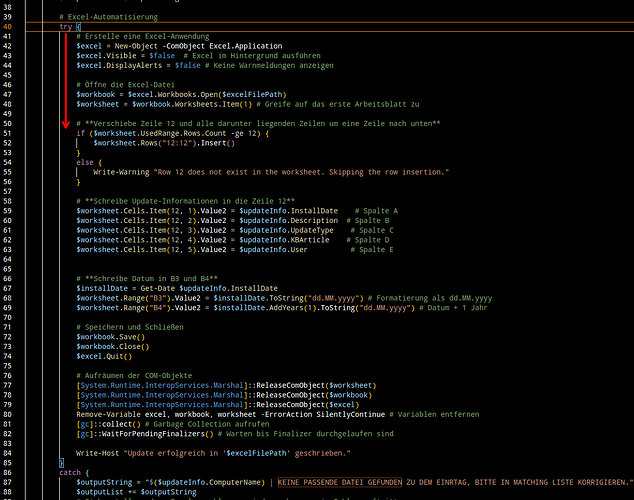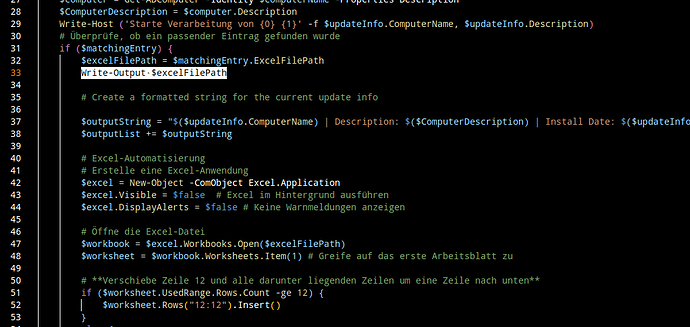Hallo zusammen,
ich habe Probleme mit einem SUVI Task. Dieser soll ein Powershell-Script ausführen, welches dann Dokumente im Work-Verzeichnis von Enaio bearbeitet. Wenn ich das Script von Hand mit dem User ausführe, welcher auch im SUVI Dienst hinterlegt ist, funktioniert es Einwandfrei. Starte ich das Script aber über SUVI starte, läuft er auf einen Fehler. Zum Test habe ich es auch in die Windows Aufgabenplanung eingebunden und da funktioniert es :-/ Andere SUVI Task, in denen ich Powershell Scripte aufrufe und die auf auf Freigaben Dateien löschen etc. funktionieren Problemlos. Was macht SUVI hier anders?
Mein SUVI Task sieht so aus:
{
"type": "schedule",
"exec": "system",
"schedule": "0 2 * * *",
"args": [
"powershell.exe", "-File", "C:\\SUVI\\apps\\ServerUpdateInfos\\UpdateInfoExcelProcess.ps1"
],
"cwd": "C:\\\\Windows\\\\System32\\\\WindowsPowerShell\\\\v1.0",
"env": {"KONFIG_PFAD": "C:\\SUVI/config","SERVICE_NAME": "ProcessUpdateInfos", "LOG_PFAD": "C:\\SUVI/log", "LOG_LEVEL": "INFO"},
"info": "## Trage Daten aus Updateinfo.csv in Doumentationen in enaio"
}
Das Powershell Script:
# Pfade zu den CSV-Dateien
$updateInfoCsvPath = "C:\SUVI\apps\ServerUpdateInfos\updateinfo.csv"
$matchingCsvPath = "C:\SUVI\apps\ServerUpdateInfos\Matching.csv"
$sendTo = "Test@kreis-reutlingen.de"
# Importiere die CSV-Dateien
try {
$updateInfos = Import-Csv -Path $updateInfoCsvPath -Delimiter ";" -Header "ComputerName", "InstallDate", "Description", "UpdateType", "KBArticle", "User"
$matchingData = Import-Csv -Path $matchingCsvPath -Delimiter ";" -Header "ComputerName", "ExcelFilePath"
}
catch {
Write-Error "Fehler beim Importieren der CSV-Dateien: $($_.Exception.Message)"
exit
}
# Initialize an empty array to store the output
$outputList = @()
# Schleife durch die Update-Informationen
foreach ($updateInfo in $updateInfos) {
# Finde den passenden Eintrag in der Matching-Datei
$matchingEntry = $matchingData | Where-Object { $_.ComputerName -eq $updateInfo.ComputerName }
$computerName = $updateInfo.ComputerName
$computer = Get-ADComputer -Identity $computerName -Properties Description
$ComputerDescription = $computer.Description
Write-Host ('Starte Verarbeitung von {0} {1}' -f $updateInfo.ComputerName, $updateInfo.Description)
# Überprüfe, ob ein passender Eintrag gefunden wurde
if ($matchingEntry) {
$excelFilePath = $matchingEntry.ExcelFilePath
# Create a formatted string for the current update info
$outputString = "$($updateInfo.ComputerName) | Description: $($ComputerDescription) | Install Date: $($updateInfo.InstallDate) | Update Type: $($updateInfo.UpdateType) | KB Article: $($updateInfo.KBArticle) | User: $($updateInfo.User)"
$outputList += $outputString
# Excel-Automatisierung
try {
# Erstelle eine Excel-Anwendung
$excel = New-Object -ComObject Excel.Application
$excel.Visible = $false # Excel im Hintergrund ausführen
$excel.DisplayAlerts = $false # Keine Warnmeldungen anzeigen
# Öffne die Excel-Datei
$workbook = $excel.Workbooks.Open($excelFilePath)
$worksheet = $workbook.Worksheets.Item(1) # Greife auf das erste Arbeitsblatt zu
# **Verschiebe Zeile 12 und alle darunter liegenden Zeilen um eine Zeile nach unten**
if ($worksheet.UsedRange.Rows.Count -ge 12) {
$worksheet.Rows("12:12").Insert()
}
else {
Write-Warning "Row 12 does not exist in the worksheet. Skipping the row insertion."
}
# **Schreibe Update-Informationen in die Zeile 12**
$worksheet.Cells.Item(12, 1).Value2 = $updateInfo.InstallDate # Spalte A
$worksheet.Cells.Item(12, 2).Value2 = $updateInfo.Description # Spalte B
$worksheet.Cells.Item(12, 3).Value2 = $updateInfo.UpdateType # Spalte C
$worksheet.Cells.Item(12, 4).Value2 = $updateInfo.KBArticle # Spalte D
$worksheet.Cells.Item(12, 5).Value2 = $updateInfo.User # Spalte E
# **Schreibe Datum in B3 und B4**
$installDate = Get-Date $updateInfo.InstallDate
$worksheet.Range("B3").Value2 = $installDate.ToString("dd.MM.yyyy") # Formatierung als dd.MM.yyyy
$worksheet.Range("B4").Value2 = $installDate.AddYears(1).ToString("dd.MM.yyyy") # Datum + 1 Jahr
# Speichern und Schließen
$workbook.Save()
$workbook.Close()
$excel.Quit()
# Aufräumen der COM-Objekte
[System.Runtime.InteropServices.Marshal]::ReleaseComObject($worksheet)
[System.Runtime.InteropServices.Marshal]::ReleaseComObject($workbook)
[System.Runtime.InteropServices.Marshal]::ReleaseComObject($excel)
Remove-Variable excel, workbook, worksheet -ErrorAction SilentlyContinue # Variablen entfernen
[gc]::collect() # Garbage Collection aufrufen
[gc]::WaitForPendingFinalizers() # Warten bis Finalizer durchgelaufen sind
Write-Host "Update erfolgreich in '$excelFilePath' geschrieben."
}
catch {
$outputString = "$($updateInfo.ComputerName) | KEINE PASSENDE DATEI GEFUNDEN ZU DEM EINRTAG, BITTE IN MATCHING LISTE KORRIGIEREN."
$outputList += $outputString
# Sicherstellen, dass Excel geschlossen wird, auch wenn ein Fehler auftritt
if ($workbook) {
$workbook.Close($false) # Änderungen nicht speichern, falls Fehler aufgetreten sind
[System.Runtime.InteropServices.Marshal]::ReleaseComObject($workbook)
}
if ($excel) {
$excel.Quit()
[System.Runtime.InteropServices.Marshal]::ReleaseComObject($excel)
}
Remove-Variable excel, workbook, worksheet -ErrorAction SilentlyContinue # Variablen entfernen
[gc]::collect() # Garbage Collection aufrufen
[gc]::WaitForPendingFinalizers() # Warten bis Finalizer durchgelaufen sind
}
}
else {
Write-host "Kein passender Eintrag für Computer '$($updateInfo.ComputerName)' in der Matching-Datei gefunden."
write-host $excelFilePath
# Create a formatted string for the current update info
$outputString = "$($updateInfo.ComputerName) | Description: $($Description) | Install Date: $($updateInfo.InstallDate) | Update Type: $($updateInfo.UpdateType) | KB Article: $($updateInfo.KBArticle) | User: $($updateInfo.User) $newline"
# Add the formatted string to the output list
$outputList += $outputString
$outputString = "$($updateInfo.ComputerName) | KEINE PASSENDE EINTRAG GEFUNDEN, BITTE IN MATCHING LISTE EINTRAGEN."
$outputList += $outputString
}
}
Write-Host "Skript abgeschlossen."
# === Umbenennen und Verschieben der CSV-Datei ===
# Erstelle den Pfad zum Backup-Ordner (wenn er nicht existiert)
$backupFolderPath = Join-Path -Path (Split-Path -Path $updateInfoCsvPath) -ChildPath "Backup"
if (!(Test-Path -Path $backupFolderPath -PathType Container)) {
try {
New-Item -ItemType Directory -Path $backupFolderPath -ErrorAction Stop
Write-Host "Backup-Ordner '$backupFolderPath' erstellt."
}
catch {
Write-Error "Fehler beim Erstellen des Backup-Ordners: $($_.Exception.Message)"
}
}
# Erstelle den neuen Dateinamen mit dem aktuellen Datum als Präfix
$currentDate = Get-Date -Format "yyyyMMdd"
$originalFileName = Split-Path -Path $updateInfoCsvPath -Leaf
$newFileName = "$($currentDate)_$originalFileName"
$newFilePath = Join-Path -Path $backupFolderPath -ChildPath $newFileName
# Verschiebe die Datei in den Backup-Ordner und benenne sie um
try {
Move-Item -Path $updateInfoCsvPath -Destination $newFilePath -ErrorAction Stop
Write-Host "Datei '$originalFileName' wurde umbenannt in '$newFileName' und nach '$backupFolderPath' verschoben."
}
catch {
Write-Error "Fehler beim Umbenennen und Verschieben der Datei: $($_.Exception.Message)"
}
if ($outputList) {
$emailBody = ($outputList -join "<br>`n")
start-LRASendMail `
-Header 'Auf folgenden Servern wurden seit gestern Updates installiert.' `
-MailAddress $sendTo `
-Subject 'Server Updates' `
-Body $emailBody
Write-Host 'E-Mail gesendet'
}
Write-Host 'Verarbeitung beendet'

